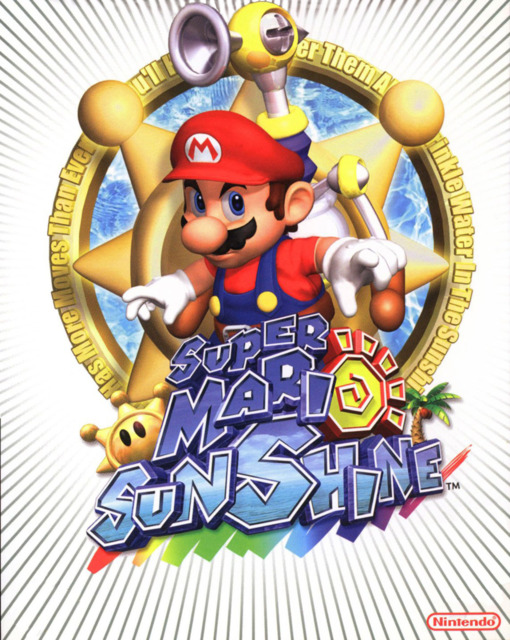The only vacation here is the one the developers took.
You could basically say I bought my Gamecube for Super Mario Sunshine, I suppose. Like everybody else, I fell in love with Super Mario 64. The idea of more Super Mario 64? Sign me up. Finally, somewhere around Christmas 2004, I managed to pick up a Gamecube; and, as I just mentioned, the first game I bought with my Gamecube was Super Mario Sunshine.
The introductory cutscene sets the stage for the game: Mario, the Princess, and a few assorted Toads (including Toadsworth, though the game never really explains what his role is in the monarchy of the Mushroom Kingdom) are off on vacation to Isle Delfino, a tropical paradise offering up the best in entertainment, relaxation, and cuisine. No sooner does their airplane land, and Mario is thrown in jail for defacing the island with a strange paint-like substance and scaring away the Shine sprites. The Shine sprites are what keep the island bright and sunny all year - and since their absence, Delfino has been plunged in to darkness. Though wrongly accused, Mario is released from jail on the grounds that he clean up the mess he has supposedly made with the aid of the FLUDD - a water-spraying device used to wash away the paint covering the island.
Throughout, this game is up front about it: This isn’t the Mushroom Kingdom anymore. Deep, intricate plots have never really been Mario’s forté, but Super Mario Sunshine is daring in its storyline presentation. Unfortunately, the Mario universe was never really designed for this sort of thing; all the characters have squeaky, obnoxious voices and personalities that aren’t really adept at speaking full lines of dialog. This immediately makes most of the cutscenes somewhat difficult to watch - Princess Peach in particular seems to have all of the intelligence of a sack of hammers and the tone of her voice often paints her as totally oblivious to anything that is happening - a stereotypical blonde, in a way. I love Mario and I love the characters, but they were created a certain way for a reason. Trying to jam them in to a deeper plot like this doesn’t feel natural.
And the game’s increased focus on plot doesn’t stop there - it extends itself to alter many of the things in which I enjoyed about Super Mario 64. The main obstacle this presents to me is that it makes Super Mario Sunshine a very linear experience; the plot dictates what levels open up and when they open up, and each level is broken up in to a set of “episodes”. Each level has it’s own specific plot thread, and as a result, you aren’t allowed to access the “episodes” out of order (otherwise you would run the risk of messing the plot up).
This is in contrast to Super Mario 64, which featured massive playground-like levels that simply begged to be explored. At any given time in Super Mario 64, you had entire sets of levels open up simultaneously, and every level had a number of objectives that could be tackled in any order you felt like completing them in. This lent a fun sense of discovery to Super Mario 64, an element synonymous with its creator, Shigeru Miyamoto. Super Mario Sunshine removes this sense of discovery in favor of its unwanted emphasis on story progression. The end result are the same massive playground-like levels, but with no reason to venture off the beaten path until the game’s storyline explicitly tells you to.
Not that the levels are particularly exciting in themselves, however. Given the game’s tropical island theme, the majority of the levels in the game feel too similar - in any other Mario game, the “tropical island theme” would last for one level (or maybe one world, depending on what you’re playing). Super Mario Sunshine, however, rides the theme for nearly the entire game, making every level feel equally bland and uninspired. Making this worse are the objectives presented to you in each “Episode” - the majority of them get recycled across the entire game; in each level you be asked to collect 8 red coins, in each level you will race Piantissimo to a specified finish line, in each level you ultimately face off against Shadow Mario, the devious impostor who has soiled Mario’s good name. A lot of bosses also get recycled - most boss characters (such as Petey Piranha) have to be defeated more than once. The cherry on top is Yoshi’s tragic appearance in the game: The poor dinosaur is nearly worthless. His only use is to clear away one specific type of paint that Mario’s FLUDD cannot handle, and worst of all, Yoshi has developed a fatal allergic reaction to water. Should Yoshi touch water, he dies instantly. How an animal such as Yoshi can survive at all on waterlogged island such as Isle Delfino is a mystery to me, especially considering he never seemed to have trouble with water in past Mario games.
That’s not to say Super Mario Sunshine is all bad, though. A high point in the game are the Secret Bonus levels. Generally noted as having an Episode Title like, “The Secret Of…”, these levels teleport Mario off to a psychedelic world (sans FLUDD) that hearkens back to the classic Mario platforming challenges of the NES and SNES. Even the music brings back a fond nostalgia, with a jazzy "a capella" remix of the Super Mario Brothers theme. Nothing but fun simplicity and hardcore challenge (Usually this is where I would say, “an entire game like this would be awesome” - but that’s kinda-sorta been answered with Super Mario Galaxy on the Wii).
Unfortunately, it’s not enough to save Super Mario Sunshine. While not really a bad game, it’s good enough to be passable - but Nintendo didn’t build it’s company on games that were merely “good enough”.
